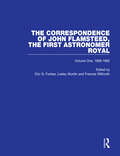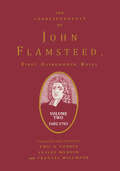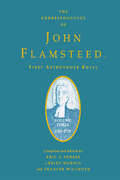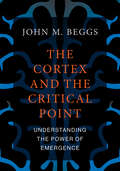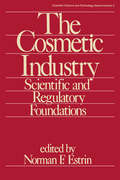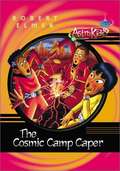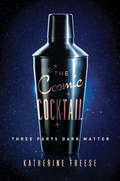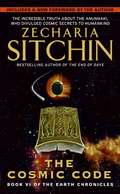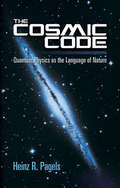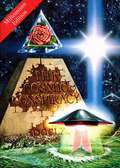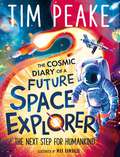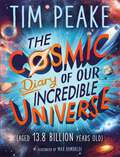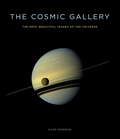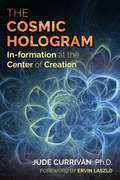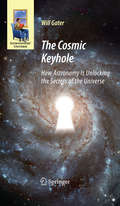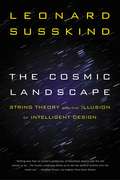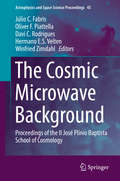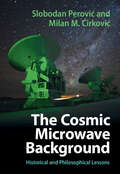- Table View
- List View
The Correspondence of John Flamsteed, The First Astronomer Royal: Volume 1
by Lesley Murdin Frances Willmoth Eric G. Forbes Maria ForbesProfessor Eric Forbes left behind at his death an important collection of the letters of John Flamsteed (1646-1719), First Astronomer Royal. A leading figure in the final phases of the seventeenth-century scientific revolution, his extensive correspondence with 129 British and foreign scholars all over the world touches on many of the scientific discussions of the day.A detailed, scholarly work of reference, The Correspondence of John Flamsteed, The First Astronomer Royal: Volume 1 is an essential guide to the exciting developments in scientific thinking that occurred during the seventeenth century. It supplements the published correspondence of Isaac Newton and Henry Oldenburg, and will be an invaluable research tool, not only for historians of astronomy, but also for researchers examining how scientific thought developed.
The Correspondence of John Flamsteed, The First Astronomer Royal: Volume 2
by Lesley Murdin Frances Willmoth Eric G. Forbes Maria ForbesThe Correspondence of John Flamsteed: The First Astronomer Royal, Volume Two contains the letters Flamsteed wrote and received from June 1682 to the spring of 1703. A leading figure in the final phases of the seventeenth-century scientific revolution, his extensive correspondence with 129 British and foreign scholars touches on many of the scientific discussions of the day. Some of these exchanges involved established correspondents, chiefly Newton and Wallis, but members of a younger generation, such as Stephen Gray, William Derham, and Abraham Sharp, appear with increasing frequency, especially after 1700.
The Correspondence of John Flamsteed, The First Astronomer Royal: Volume 3
by Lesley Murdin Frances WillmothThe Correspondence of John Flamsteed discusses this leading figure in the final phases of the seventeenth-century scientific revolution, presents his extensive correspondence with 129 British and foreign scholars all over the world, and touches on many of the scientific discussions of the day. This book, the last volume of the set, contains his let
The Cortex and the Critical Point: Understanding the Power of Emergence
by John M. BeggsHow the cerebral cortex operates near a critical phase transition point for optimum performance.Individual neurons have limited computational powers, but when they work together, it is almost like magic. Firing synchronously and then breaking off to improvise by themselves, they can be paradoxically both independent and interdependent. This happens near the critical point: when neurons are poised between a phase where activity is damped and a phase where it is amplified, where information processing is optimized, and complex emergent activity patterns arise. The claim that neurons in the cortex work best when they operate near the critical point is known as the criticality hypothesis. In this book John Beggs—one of the pioneers of this hypothesis—offers an introduction to the critical point and its relevance to the brain.Drawing on recent experimental evidence, Beggs first explains the main ideas underlying the criticality hypotheses and emergent phenomena. He then discusses the critical point and its two main consequences—first, scale-free properties that confer optimum information processing; and second, universality, or the idea that complex emergent phenomena, like that seen near the critical point, can be explained by relatively simple models that are applicable across species and scale. Finally, Beggs considers future directions for the field, including research on homeostatic regulation, quasicriticality, and the expansion of the cortex and intelligence. An appendix provides technical material; many chapters include exercises that use freely available code and data sets.
The Cosmetic Industry: Norman F. (Cosmetic Science And Technology Ser.)
by EstrinThis book summarizes the authority of regulatory agencies and programs as they pertain to the cosmetic industry, offers practical advice on how to operate within the regulatory environment, and introduces scientific and regulatory issues that are likely to have an impact on cosmetic manufacturers. "This interesting volume reports all the novel technologies in use to study and control the cosmetic products in order to make them effective and free of side effects." ---Journal of Applied Cosmetology, 2000
The Cosmic Camp Caper (AstroKids #6)
by Robert ElmerThe gang thought they would be roasting marshmallows over miniature volcanoes and practicing laser archery, but instead, Camp Little Dipper proves to be something else entirely. Book 6 of AstroKids.
The Cosmic Century
by Malcolm S. LongairThe twentieth-century witnessed the development of astrophysics and cosmology from subjects which scarcely existed to two of the most exciting and demanding areas of contemporary scientific inquiry. In this book Malcolm Longair reviews the historical development of the key areas of modern astrophysics, linking the strands together to show how they have led to the extraordinarily rich panorama of modern astrophysics and cosmology. While many of the great discoveries were derived from pioneering observations, the emphasis is upon the development of theoretical concepts and how they came to be accepted. These advances have led astrophysicists and cosmologists to ask some of the deepest questions about the nature of our Universe and have pushed astronomical observations to the very limit. This is a fantastic story, and one which would have defied the imaginations of even the greatest story-tellers.
The Cosmic Cocktail: Three Parts Dark Matter (Science Essentials #27)
by Katherine FreeseThe inside story of the epic quest to solve the mystery of dark matterThe ordinary atoms that make up the known universe—from our bodies and the air we breathe to the planets and stars—constitute only 5 percent of all matter and energy in the cosmos. The rest is known as dark matter and dark energy, because their precise identities are unknown. The Cosmic Cocktail is the inside story of the epic quest to solve one of the most compelling enigmas of modern science—what is the universe made of?—told by one of today's foremost pioneers in the study of dark matter.Blending cutting-edge science with her own behind-the-scenes insights as a leading researcher in the field, acclaimed theoretical physicist Katherine Freese recounts the hunt for dark matter, from the discoveries of visionary scientists like Fritz Zwicky—the Swiss astronomer who coined the term "dark matter" in 1933—to the deluge of data today from underground laboratories, satellites in space, and the Large Hadron Collider. Theorists contend that dark matter consists of fundamental particles known as WIMPs, or weakly interacting massive particles. Billions of them pass through our bodies every second without us even realizing it, yet their gravitational pull is capable of whirling stars and gas at breakneck speeds around the centers of galaxies, and bending light from distant bright objects. Freese describes the larger-than-life characters and clashing personalities behind the race to identify these elusive particles.Many cosmologists believe we are on the verge of solving the mystery. The Cosmic Cocktail provides the foundation needed to fully fathom this epochal moment in humankind’s quest to understand the universe.
The Cosmic Code (The Earth Chronicles #6)
by Zecharia SitchinMany thousands of years ago, a race of extraordinary beings guided the evolution of life on Earth -- determining the existence and nature of mankind as we know it today. All powerful, all knowing, the proof of their genius is apparent in the mysterious monoliths at Stonehenge, and in a strange but highly significant structure of concentric stone circles in Israel's Golan Heights -- both requiring sophisticated astronomical knowledge. Teaching man to look to the heavens, they bequeathed to us the Cosmic Code. The newest entry in a carefully researched multi-volume series tracing the creation and motivation of mankind, this book identifies the turning point in our species' delicate balance between the demands of destiny and the vagaries of fate. From deep inside ancient Sumerian texts that predate even the Bible, Zecharia Sitchin dares to reveal the nature of prophecy and historical truths that have long been obscured by disbelief and misunderstanding: the code used to construct our kind by master builder from the stars.
The Cosmic Code: Quantum Physics As The Language Of Nature (Dover Books On Physics Series)
by Heinz R. PagelsThis is one of the most important books on quantum mechanics ever written for general readers, in which an eminent physicist discusses and explains the core concepts of physics without resorting to complicated mathematics. "Can be read by anyone. I heartily recommend it!" -- New York Times Book Review. 1982 edition.
The Cosmic Code: Quantum Physics as the Language of Nature
by Heinz R. PagelsDescribes the development of the quantum theory of the atom. Describes "The Voyage into Matter." Physicists, extending human consciousness into the farthest reaches of space and time, deep into the structure of matter, find that beyond the molecule and atom lies a new realm. The core of the atom is the nucleus. Describes the nature of physical laws and how physicists find them. This part also contains some personal reflections on the meaning of the scientific enterprise--that through the activity of science and technology the discovered order of the universe, what I call the cosmic code, becomes a program for historical change.
The Cosmic Conspiracy
by Stan Deyo Holly DeyoThis book takes you through a history of secret societies from ancient Babalon, Egypt, the early church and their involvement in world dominance. Stan's involvement in the FBI and testing of cutting edge flight crafts, anti-gravity and his plans on building such crafts. He explains the who and how of our declaration if Independence, constitution and the great seal of the U.S.A was created.
The Cosmic Diary of a Future Space Explorer: The Next Step for Humankind (The Cosmic Diary of)
by Steve Cole Tim PeakeDear Diary, hello to Planet Earth! Today I'm far from home, floating around in the atmosphere, and wow the stars look magical from here... Do you want to know what it's like to be a REAL-LIFE astronaut? If you've ever wanted to blast off into space, you're about to find out everything you need to become an astronaut - and the answers to all the big questions like, how do you wee in space? What can you see from the International Space Station? And how could we build a colony on Mars?Your mission, if you choose to accept, is to pull on your spacesuit and join your guide, real astronaut Tim Peake (and a host of expert STEM characters) in this fascinating adventure through space, time and the diary of one truly incredible space adventure. Join us for some iconic space adventures, plus discover the voyages we might make in the future...Written by real-life astronaut Tim Peake, this children's non-fiction book is essential for readers who want to blast into space and discover more about the universe and our place in it.
The Cosmic Diary of a Future Space Explorer: The Next Step for Humankind (The Cosmic Diary of)
by Steve Cole Tim PeakeA real-life astronaut is here to tell you what it's REALLY like to blast off into space - and everywhere we might travel in the future! Could we build a colony on Mars? Will we ever land on Venus? Can we play football on the Moon?Your mission, if you choose to accept, is to pull on your spacesuit and join your guide, real astronaut Tim Peake (and a host of expert STEM characters), in this fascinating adventure through space, time and the diary of one truly incredible space adventure. With help from some robot adventurers, you'll discover space missions of the past and present, and where we might travel in the future . . .Written by real-life astronaut Tim Peake, this children's non-fiction book is essential for readers who want to discover more about space travel, the universe and our place in it.
The Cosmic Diary of our Incredible Universe (The Cosmic Diary of)
by Tim PeakeDISCOVER THE UNIVERSE'S SECRETS WITH THIS FASCINATING FACT-FILLED BOOK FROM REAL-LIFE ASTRONAUT TIM PEAKEAre you bursting to know the answers to REALLY BIG questions? Like, how are stars made? What will we find in a black hole? Which fruit can create antimatter? What even IS antimatter?Well, put on your seatbelts and blast into space with your guide, astronaut Tim Peake, and a host of space experts in this fascinating adventure through space, time and the diary of our truly incredible universe.The perfect gift for kids hungry to know more about space, the universe and our place in it. Written in an accessible and fun diary style, with bright, bold and brilliant illustrations by Max Rambaldi.
The Cosmic Frontiers of General Relativity
by William J. Kaufmann IIIFor thousands of years people have gazed into the star-filled nighttime sky and felt a sense of mystery and wonder. Even in the most ancient times, before recorded history, people have marveled at the orderly workings of the heavens. The rising and setting of the sun, the silver moon going thought its phases, the drama of an eclipse, and the wanderings of the planets among the constellations of the zodiac proved sufficient to inspire our ancestors to take up the study of astronomy.
The Cosmic Gallery: The Most Beautiful Images of the Universe
by Giles SparrowThe heavens are alive with breathtaking beauty: from the incandescent surface of the Sun to the shimmering tail of a comet; the birth of planets to the death of stars; the dancing shadows of Jupiter's moons to the silhouettes of eclipses. The Cosmic Gallery contemplates the entire cosmos as a grand celestial art exhibit. In six thematically organized chapters, Giles Sparrow presents an array of stunning images, ranging from easily seen phenomena to the most distant and intricate galaxies, providing the reader with an exciting and beautiful new perspective on the cosmos.
The Cosmic Gallery: The Most Beautiful Images of the Universe
by Giles SparrowThe heavens are alive with breathtaking beauty: from the incandescent surface of the Sun to the shimmering tail of a comet; the birth of planets to the death of stars; the dancing shadows of Jupiter's moons to the silhouettes of eclipses. The Cosmic Gallery contemplates the entire cosmos as a grand celestial art exhibit. In six thematically organized chapters, Giles Sparrow presents an array of stunning images, ranging from easily seen phenomena to the most distant and intricate galaxies, providing the reader with an exciting and beautiful new perspective on the cosmos.
The Cosmic Hologram: In-formation at the Center of Creation
by Ervin Laszlo Jude CurrivanHow holographic patterns of information underlie our physical reality• Includes myriad evidence from a wide range of cutting-edge scientific discoveries showing our Universe is an interconnected hologram of information• Explains how consciousness is a major component of the cosmic hologram of information, making us both manifestations and co-creators of our reality• Reconciles Quantum Mechanics and Einstein’s Theory of Relativity by showing that energy-matter and space-time are complementary expressions of informationOur understanding of the Universe is about to transform at all levels, from the tiniest Planck scale to the vast reaches of space. Recent scientific discoveries show that the information that upholds all of our modern technologies is exactly the same as the universal in-formation that underpins, pervades, and is all we call physical reality.Exploring how information is more fundamental than energy, matter, space, or time, Jude Currivan, Ph.D., examines the latest research across many fields of study and many scales of existence to show how our Universe is in-formed and holographically manifested. She explains how the fractal in-formational patterns that guide behavior at the atomic level also guide the structure of galactic clusters in space. She demonstrates how the in-formational relationships that underlie earthquakes are the same as those that play out during human conflicts. She shows how cities grow in the same in-formational ways that galaxies evolve and how the dynamic in-formational forms that pervade ecosystems are identical to the informational structures of the Internet and our social behaviors. Demonstrating how information is physically real, the author explores how consciousness connects us to the many interconnected layers of universal in-formation, making us both manifestations and co-creators of the cosmic hologram of reality. She explains how Quantum Mechanics and Einstein’s Theory of Relativity can at last be reconciled if we consider energy-matter and space-time as complementary expressions of information, and she explores how the cosmic hologram underlies the true origin of species and our own evolution.Concurring too with ancient spiritual wisdom, the author offers solid evidence that consciousness is not something we “have” but the fundamental nature of what we and the entire Universe are. With this understanding, we can each transform our own lives and help co-create and in-form the world around us.
The Cosmic Keyhole
by Will GaterIn the last thirty years humans have probed the Universe, explored the Solar System and visited with spacecraft some of the most incredible places humans have ever laid eyes upon. We have expanded our knowledge slowly and surely, but still now only see a glimpse of the bigger picture. The Cosmic Keyhole explores the big discoveries of recent years and asks what's next? How prolific is life in the Universe? How far back to the Big Bang can we probe? And what hidden treasures still await us in the hidden corners of our Solar System?
The Cosmic Landscape: String Theory and the Illusion of Intelligent Design
by Leonard SusskindIn his first book ever, the father of string theory reinvents our concept of the known universe and man's unique place within it. The beginning of the 21st century is a watershed in modern science, a time that will forever change our understanding of the universe, Leonard Susskind contends. Several decades ago, Susskind introduced the revolutionary concept of string theory to the world of physical science. In doing so, he inspired a generation of physicists who believed that the theory would uniquely predict the properties of our universe. Now, in his first book ever, Susskind argues that the very idea of such an elegant theory no longer suits our understanding of the universe, and that our narrow 20th-century view of a unique universe will have to give way to the much broader concept of a gigantic cosmic landscape--a megaverse, pregnant with new possibilities. His other contributions to physics are too numerous to mention, but his recent victory in an argument with Stephen Hawking over the nature of black holes made headlines everywhere.
The Cosmic Microwave Background
by Júlio C. Fabris Oliver F. Piattella Davi C. Rodrigues Hermano E.S. Velten Winfried ZimdahlThe series of texts composing this book is based on the lectures presented during the II Jos#65533; Pl#65533;nio Baptista School of Cosmology, held in Pedra Azul (Esp#65533;rito Santo, Brazil) between 9 and 14 March 2014. This II JBPCosmo has been entirely devoted to the problem of understanding theoretical and observational aspects of Cosmic Background Radiation (CMB). The CMB is one of the most important phenomena in Physics and a fundamental probe of our Universe when it was only 400,000 years old. It is an extraordinary laboratory where we can learn from particle physics to cosmology; its discovery in 1965 has been a landmark event in the history of physics. The observations of the anisotropy of the cosmic microwave background radiation through the satellites COBE, WMAP and Planck provided a huge amount of data which are being analyzed in order to discover important informations regarding the composition of our universe and the process of structure formation.
The Cosmic Microwave Background
by Rhodri EvansRhodri Evans tells the story of what we know about the universe, from Jacobus Kapteyn's Island universe at the turn of the 20th Century, and the discovery by Hubble that the nebulae were external to our own galaxy, through Gamow's early work on the cosmic microwave background (CMB) and its subsequent discovery by Penzias and Wilson, to modern day satellite-lead CMB research. Research results from the ground-based experiments DASI, BOOMERANG, and satellite missions COBE, WMAP and Planck are explained and interpreted to show how our current picture of the universe was arrived at, and the author looks at the future of CMB research and what we still need to learn. This account is enlivened by Dr Rhodri Evans' personal connections to the characters and places in the story.
The Cosmic Microwave Background
by Ruth DurrerThe Cosmic Microwave Background (CMB), the radiation left over from the Big Bang, is arguably the most important topic in modern cosmology. Its theory and observation have revolutionized cosmology from an order-of-magnitude science to a precision science. This graduate textbook describes CMB physics from first principles in a detailed yet pedagogical way, assuming only that the reader has a working knowledge of General Relativity. Among the changes in this second edition are new chapters on non-Gaussianities in the CMB and on large-scale structure, and extended discussions on lensing and baryon acoustic oscillations, topics that have developed significantly in the last decade. Discussions of CMB experiments have been updated from WMAP data to the new Planck data. The CMB success story in estimating cosmological parameters is then treated in detail, conveying the beauty of the interplay of theoretical understanding and precise experimental measurements.
The Cosmic Microwave Background: Historical and Philosophical Lessons
by Slobodan Perovic Milan M. CirkovicThis volume tells the untold story of how observations of the cosmic microwave background radiation were interpreted in the decades following its serendipitous discovery, before the Hot Big Bang model became the accepted orthodoxy. The authors guide the reader through this history, including the many false trails and blind alleys that occurred along the way. Readers will discover how the Big Bang theory was shaped by alternative theories that exposed its weaknesses – including some that persist even today. By looking carefully at what it takes to reject an incorrect theory and the assumptions and processes at each stage, the authors examine the epistemological factors at play between an emerging scientific orthodoxy and since discarded alternatives. Their analysis of the cosmic microwave background provides a uniquely well-documented case study of theory building for a wide readership spanning cosmology, the history of physics and astronomy, and the philosophy of science more broadly.
